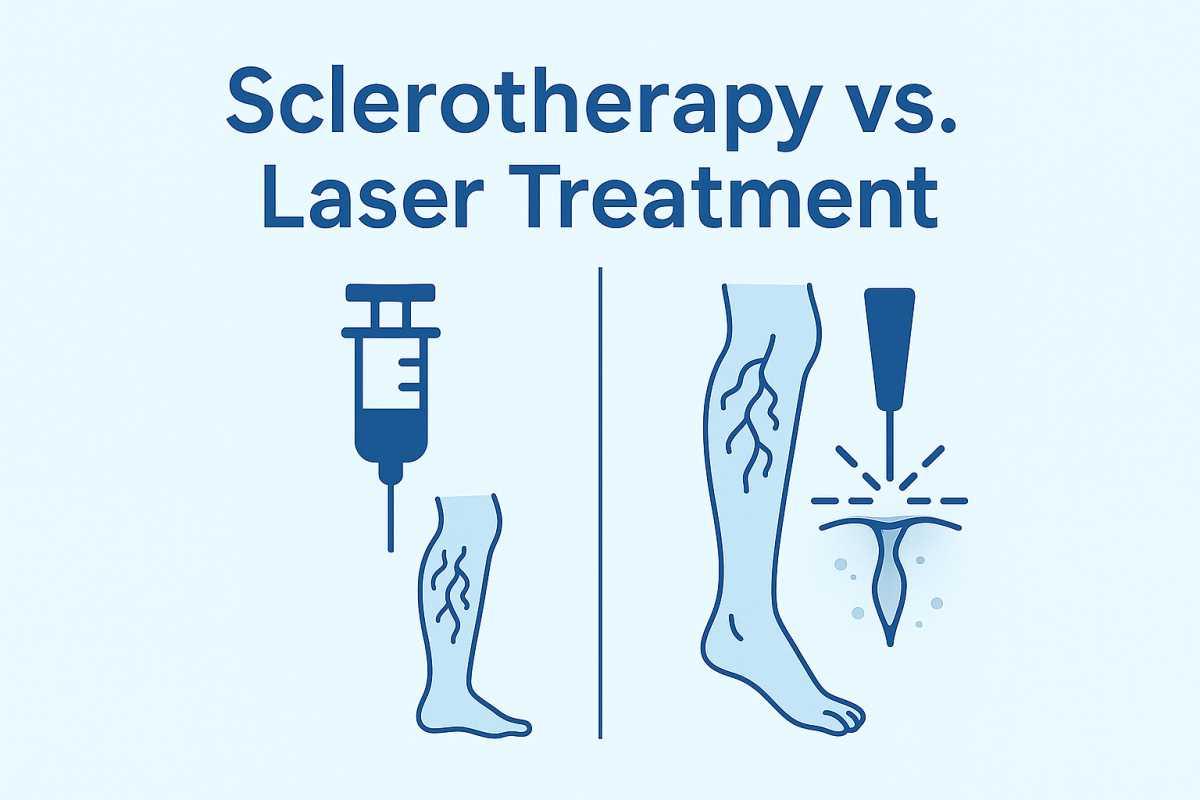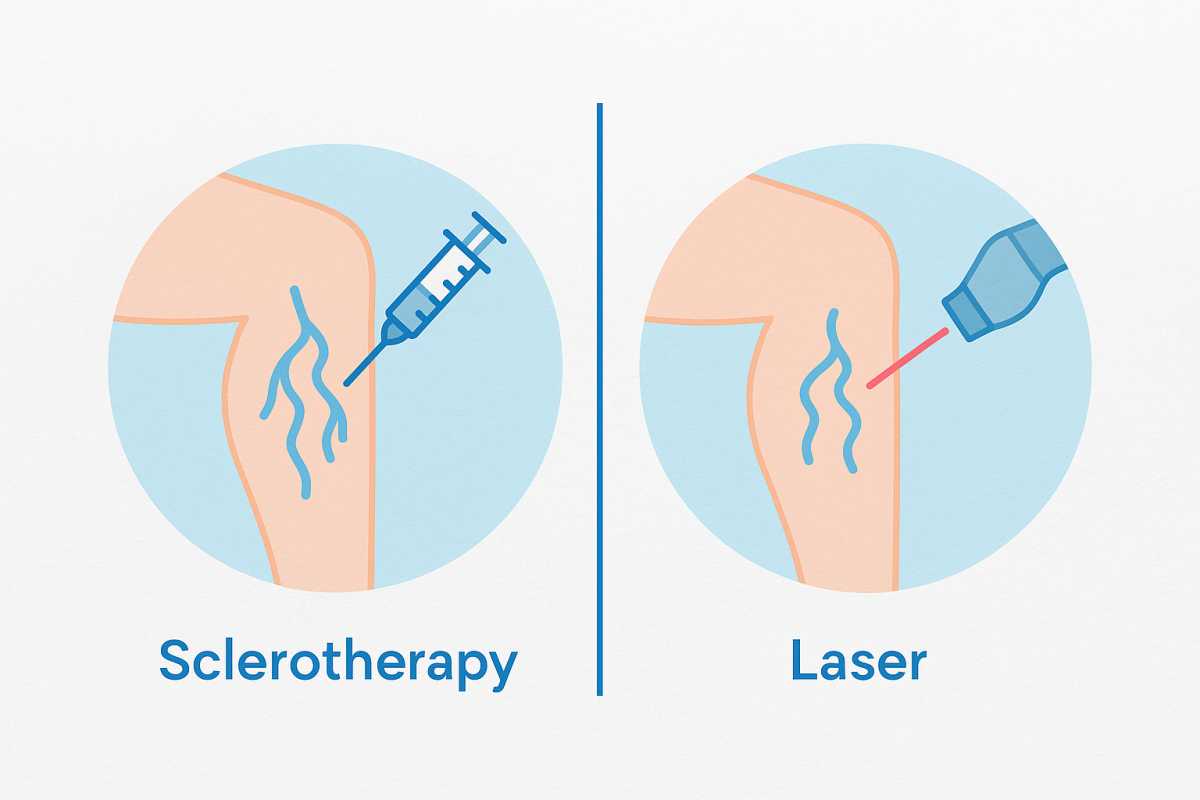When you’re staring at visible veins—blue “road maps,” red spider webs, or deeper bulges—the question becomes practical fast: Sclerotherapy vs. Laser Treatment. Both are minimally invasive, both can improve appearance and symptoms, and both can be done in an outpatient setting. The right choice has less to do with hype and more to do with vein size, depth, skin type, symptoms, and your tolerance for downtime.
Think of it like this: sclerotherapy is a targeted vein injection that makes the vessel collapse from the inside; lasers target vessels through the skin with light energy. Same goal, different tools. Matching the tool to the vein is where good results come from.
How they works?
Sclerotherapy. A very fine needle delivers a medication (sclerosant) directly into the problem vein. The inner lining gets irritated on purpose, the vein seals, and your body gradually reabsorbs it. Blood reroutes to healthier vessels. This approach is especially efficient for spider veins and small-to-medium reticular veins, and can be adapted (with foam) for some larger vessels.
Laser treatment. A device delivers light that’s absorbed by the pigment in blood within the vessel. The heat causes the vein to close. Because the skin is the access point, lasers are commonly used for very fine surface veins (including facial telangiectasias) and for patients who can’t or don’t want injections in certain areas. Different lasers have different wavelengths; experienced clinicians match the device to your skin tone and vessel type.
Who tends to do better with which?
Sclerotherapy often “wins” for:
Leg spider veins and reticular veins (the greenish/blue feeders under the skin)
Wider areas with multiple clusters (efficient to treat many vessels in one session)
Patients okay with wearing compression stockings for 1–2 weeks
Laser often “wins” for:
Very fine, superficial facial veins that are hard to inject
Situations where injections are impractical (needle-averse, certain anatomic sites)
Small red vessels that respond beautifully to light
There’s overlap, and many clinics use both approaches in the same care plan—sclerotherapy for feeders, laser for wispy surface lines.

Results, sessions, and recovery
Neither treatment is “instant.” With sclerotherapy, visible fading typically unfolds over a few weeks, with steady improvement over a couple of months. Laser can look a touch angrier the first few days (redness or mild swelling), then settles and fades. Most people need more than one session regardless of method; your total depends on how many veins you’re tackling and how your body responds.
Downtime is light for both. You’ll usually walk out of the office and go about your day. Sclerotherapy aftercare often includes compression stockings; laser aftercare leans on sun protection (SPF is non-negotiable) and avoiding excessive heat in the first days.
Related Article: Sclerotherapy for Varicose Veins
Side effects: what’s normal vs. uncommon
Sclerotherapy: expected bruising, temporary itching, a firm “cord” along a treated vein, or temporary hyperpigmentation that fades. “Matting” (tiny new surface vessels) can appear but is usually manageable with time or touch-ups.
Laser: transient redness, swelling, warmth; less commonly blistering or longer-lasting discoloration—especially if the device settings weren’t ideal for your skin type. Good clinicians test and tune parameters conservatively, particularly for darker skin tones.
Related Article: Sclerotherapy Treatment Side Effects
Serious complications are rare for both when performed by trained experts. Any sudden, severe pain, marked swelling, fever, drainage, or trouble breathing warrants prompt medical attention.
Want a single, patient-friendly overview of vein treatment options? The American Vein & Lymphatic Society maintains a clear primer you can skim: vein care.
Cost and coverage
Pricing varies by region, device, and number of sessions. Cosmetic spider-vein work is commonly out-of-pocket; medically significant varicose-vein disease may qualify for insurance coverage when symptoms and ultrasound findings meet criteria. Ask your clinic to separate cosmetic touch-ups from medically necessary care so you’re not guessing.
Choosing between them in NYC
If you’re exploring options in New York, look for centers that:
Do a proper vein mapping (duplex ultrasound for leg veins when indicated)
Offer both sclerotherapy and multiple laser platforms, not one tool for every problem
Are staffed by board-certified vein/dermatology/vascular specialists
Share before-and-after examples that match your skin tone and vein pattern
Explain a staged plan (feeders → surface work) instead of promising one-and-done miracles
NYC has the advantage of depth: plenty of clinics, plenty of subspecialists. Use that to your benefit and shop for fit, not just proximity.
Related Article: Vein Treatment Centers
A quick decision guide
Want to treat clusters of leg spider/reticular veins efficiently? → Start with sclerotherapy.
Working on tiny, superficial red lines (especially on the face)? → Consider laser.
Have mixed patterns or stubborn areas? → Blend both in a staged plan.
Sensitive to compression stockings? → Laser may be simpler for you.
Sun-heavy lifestyle or recent tan? → Sclerotherapy may be the safer first move.
Related Article: Fraksel Laser Treatment
Bottom line
There isn’t a universal winner in Sclerotherapy vs. Laser Treatment. The best choice is the one that matches your veins, your skin, and your goals—often a thoughtful mix of both. With a careful exam, realistic timelines, and a provider who treats patterns (not just spots), you can expect steady, visible improvement without putting your life on hold.
